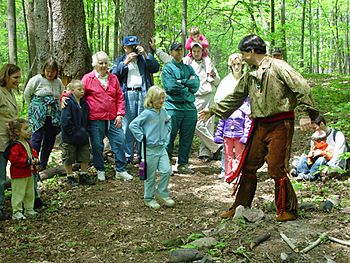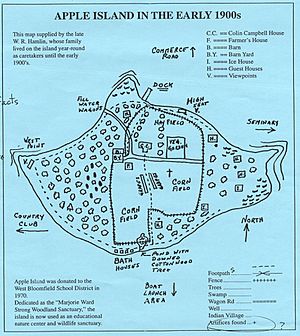Apple Island (Michigan) facts for kids

Métis reenactor on Apple Island
|
|
| Geography | |
|---|---|
| Location | Orchard Lake |
| Coordinates | 42°35′21″N 83°22′18″W / 42.58917°N 83.37167°W |
| Area | 0.14 km2 (0.054 sq mi) |
| Administration | |
| State | Michigan |
| County | Oakland County |
| City | Orchard Lake Village |
| Demographics | |
| Population | Uninhabited |
| Ethnic groups | |
|
Mount Pleasant Indian Industrial Boarding School
|
|
| NRHP reference No. | 100002685 |
| Added to NRHP | July 20, 2018 |
Apple Island is a 35-acre (0.14 km2) island located in the middle of Orchard Lake. It is part of Orchard Lake Village, Michigan. This island was formed a very long time ago, between 10,000 and 12,000 years ago. This was during the last ice age in the region.
Today, Apple Island is home to over 400 different kinds of plants. Many of these plants are rare in Oakland County. Long ago, Native Americans lived on Apple Island. They later gave the island to the United States in a special agreement called the Treaty of Detroit. Now, the West Bloomfield School District uses the island. It is a special place for learning about nature.
Contents
About Apple Island
Apple Island is about 37 acres (0.15 km2) in size. It stretches about three-eighths of a mile long and a quarter of a mile wide. The highest point on the island is about 960 feet (293 meters) above sea level. This is about 31 feet (9 meters) higher than the usual level of Orchard Lake. The island was created when a huge glacier from the last ice age melted away. This happened between 10,000 and 12,000 years ago.
Apple Island is like a mini-museum of nature. It has examples of almost every type of natural area found in southeastern Michigan. More than 400 types of plants grow on the island. Many of these plants are quite rare in Oakland County.
Clues from the Past
In the 1930s, someone living on Apple Island found an old bowl. It was made of pewter by the French. The bowl was full of wampum, which are beads made from shells. This bowl was likely made in the late 1700s or early 1800s. It was probably a gift from the French to the Native Americans. You can see this bowl today at the Cranbrook Collection.
In 1997, experts dug small test pits on the west side of the island. They found pieces of pottery and stone tools. However, there is no sign that pottery was made on the island. Also, there are no local rocks like flint for making tools. This means these items were probably brought to the island by people. These finds show that early Europeans had an influence on the Native people living there. More silver trade items were found during digs in 2000.
Another dig in 2008 tried to learn more. It was hard to tell exactly how long or how often Native Americans lived on the island. It's most likely that different Native American groups used the island now and then. This might have happened in the 1400s, 1500s, or early 1600s. It's also possible that different groups used it again in the late 1700s or early 1800s. More careful digging is needed to find out the full story.
Local stories, known as folklore, say that Ottawa Chief Pontiac was buried on the island. In 2008, a small dig was done at a spot called "Pontiac's Mound." The results showed that this spot was probably just a natural part of the island. It was not a burial mound made by people.
Because of its important old finds, Apple Island was added to the National Register of Historic Places in 2018.
Old Names and Meanings
In 1909, a poem by Dr. Samuel M. Leggett mentioned that the island was once called Me-Nah-Sa-Gor-Ning. The poem told a sad story about a Native American woman. Leggett said his poem was based on popular local stories.
Some say that a lake in Oakland County was called Menahsagorning. This name meant "apple place" to Native Americans. This was because of the apple trees and orchards nearby. Later, white settlers named the lake "Orchard Lake." They also named the town nearby "Orchard Lake Village" in 1827. The exact Native American words for the island are still a bit of a mystery.
A book from 1877, The History of Oakland County Michigan, said that Apple Island was once Native American reservation land. However, the book does not say where this information came from. No other old records confirm this idea. All later books that mention this rely on that 1877 publication.
First People on the Island
Native Americans might have found Apple Island as far back as 2,000 years ago. They may have liked the island because it was safe and had many natural resources. We don't know exactly which Native American tribes lived there before white settlers arrived. But each tribe left behind tools and items. The whole West Bloomfield lakes area has many hammerstones, chert spearheads, and bird stones. These were all left by Native Americans.
A very important agreement, the Treaty of Detroit, was made on November 17, 1807. In this treaty, the Odawa, Ojibwe, Wyandot, and Potawatomi people gave a large area of land to the United States government. This land included much of what is now southeastern Michigan and a small part of Ohio. Later settlers to Apple Island said that Native Americans often visited the island. They called the area "apple place" in their own language.
In 1856, Chief Okemos said, "I was born in Michigan, near Pontiac, on an island in a lake." He also said he was 30 years old when he left his birthplace. Chief Okemos might have been talking about Apple Island.
New Settlers Arrive
James Galloway's Purchase
After Native Americans gave the island to the United States, James Galloway bought it. He was from Palmyra, New York. He bought the island on June 18, 1827. He paid about eleven shillings and eight pence per acre. James Galloway probably never lived on the island himself. His name is not on the 1830 census for Michigan. But one of his sons did settle east of Pontiac. In his will, James Galloway gave Apple Island to his daughter, Julia Ann Galloway. Records show that Julia Ann's husband paid taxes on the island in 1847.
William Dow's Farm
In 1830, William Dow moved to the area with his family from Fife, Scotland. They settled on 270 acres (1.1 km2) of land between Orchard and Cass Lakes. This area is now called Dow Ridge. William Dow was likely the first white person to live on Apple Island. He bought Apple Island from the Allens for $1,050 on August 19, 1847. Dow later sold his property to John Coats. William Dow spent his last years as a farmer in West Bloomfield. He died on January 2, 1862, and is buried in Pontiac's Oak Hill Cemetery.
John Coats' Home
John Coats bought the island on June 25, 1851, for $1,600. He was from Paisley, Scotland. John Coats was the youngest son of James Coats, who invented cotton thread. John's brothers, James and Peter, started the J & P Coats Thread Co. John Coats came to the island to work for his brothers' company. He helped start Detroit's St. Andrew's Society in 1849. He also owned a store in Detroit. After leaving his business, John Coats built a beautiful single-story home on the island's highest point. It was built in the Greek Revival style. John Coats eventually went back to Scotland when his son James was old enough for school.
The Campbell Family
On August 27, 1856, John Coats sold the island to Colin Campbell for $3,050. Campbell was a successful Scottish merchant who sold dry goods. He also helped start the St. Andrew's Society. Colin Campbell's large family and friends lived on the island for almost 60 years. They planted many gardens and orchards. They also built new buildings. But the island kept its old feel. It did not have electricity, telephones, or indoor plumbing. Colin Campbell's wife, Caroline, helped start the Orchard Lake Community Church, Presbyterian in 1871.
The Ward Family
David Ward learned to be a surveyor from his father. In 1863, Ward moved to a farm at Orchard Lake. He had to move because his children were being bothered after he reported "log thieves." Ward lived on the farm, but he went back to Detroit in the winter for work.
Ward's son, Willis, wrote a book called “Orchard Lake and its Island” in 1942. The book tells stories about many families in Orchard Lake. It also talks about the different animals that used to live in the area. After Willis Ward died in 1943, his children, Marjorie Ward Strong and Harold Lee Ward, inherited the island. When Marjorie Ward Strong died in 1970, the island was given to its current owner. This is the West Bloomfield School District. They use it as an educational nature center for learning.



